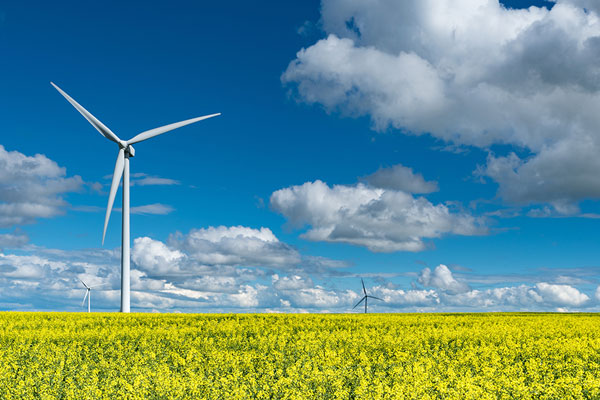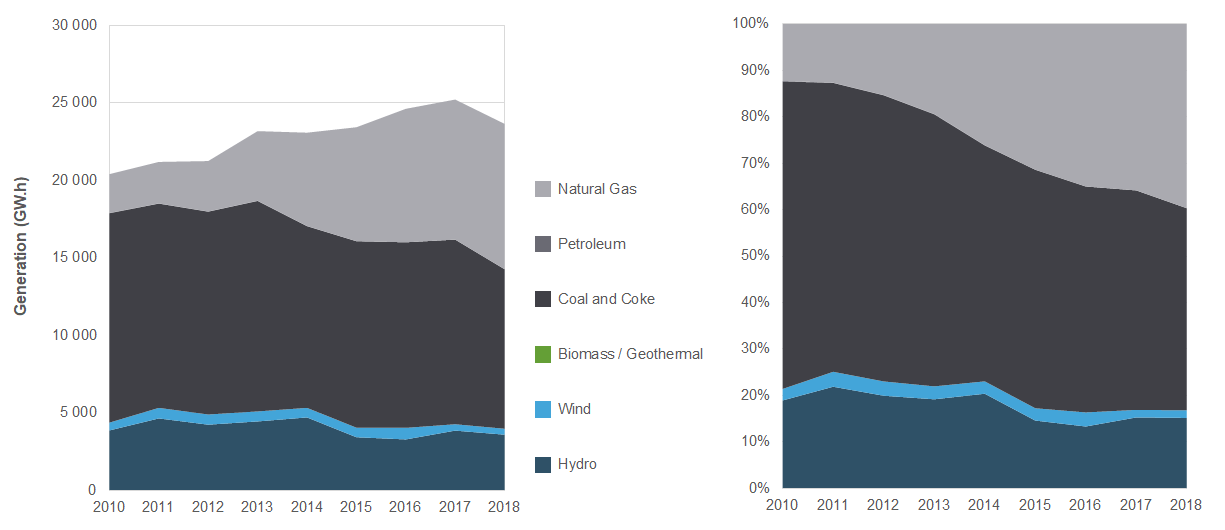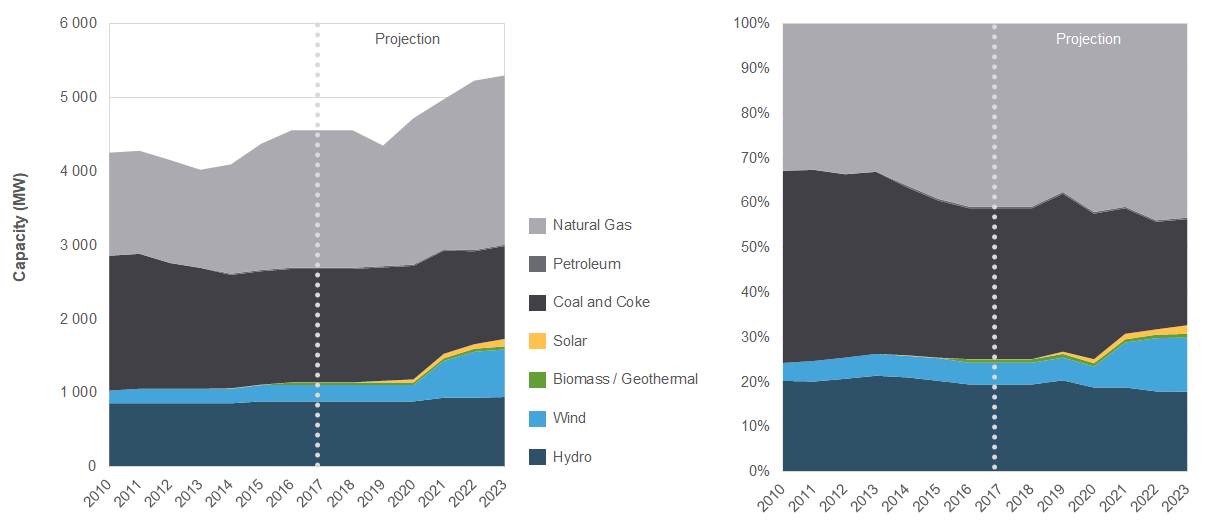Canada's Renewable Power – Saskatchewan

Saskatchewan

Saskatchewan’s renewable capacity and generation grew very little between 2010 and 2017. However, this is expected to change in the near future with notable new developments in wind, solar, biomass, and geothermal.
Generation Trends
Natural gas and coal are the primary fuels for electricity in Saskatchewan. Coal remains the largest (but declining) source of generation, while natural gas-fired generation has increased substantially since 2010. Between 2010 and 2018, coal-fired generation declined from 13 510 gigawatt-hours (GW.h) to 10 291 GW.h, while natural gas-fired generation increased from 2 504 GW.h to 9 382 GW.h. Total thermal generation in 2018 was 19 674 GW.h, or 83.2% of total generation.
Hydro is currently Saskatchewan’s largest renewable energy source, though generation can fluctuate with annual precipitation levels. In 2018, eight hydro facilities in the province generated 3 591 GW.h of electricity. Saskatchewan also has abundant wind resources and is one of the sunniest places in Canada. In 2018, 386 GW.h of electricity was generated from wind. No utility-scale solar farms were in operation yet in 2018. Total renewable generation in 2018 was 3 977 GW.h, or 16.8% of total generation.
Total electricity generation in Saskatchewan grew from 20 408 GW.h in 2010 to 23 651 GW.h in 2018. Changes in Saskatchewan’s electricity generation mix are illustrated in Figure 1.
Figure 1. Electricity Generation in Saskatchewan

Source and Description
Source: CER – Canada’s Energy Future 2020 (EF2020)
Description: This graph illustrates electricity generation from 2010 to 2018 in Saskatchewan. In 2010, Saskatchewan’s total generation was 20 408 GW.h (21.4% renewable). In 2018, total generation was 23 651 GW.h (16.4% renewable).
GHG Emissions from Electricity Generation
In 2018, Saskatchewan’s electricity sector emitted 16.1 megatonnes of carbon dioxide equivalent (MT of CO2e). Saskatchewan’s generation intensity was 680 grams CO2e per kilowatt-hour.
Saskatchewan produced 23% of Canada’s total greenhouse gas emissions from electricity generation in 2018.
Recent and Projected Capacity Changes for Renewables
Between 2010 and 2017, Saskatchewan added a net 113 megawatts (MW) of renewable capacity, primarily in the form of wind (50 MW). Between 2017 and 2023, Saskatchewan is projected to add 587 MW of new net renewable capacity. These capacity changes are illustrated in Figure 2 with data provided in Table 1.
Future projects included in the projection are:
- DEEP Geothermal, which is expected to add 5 MW in 2022.
- Golden South Wind Project, which is expected to add 200 MW in 2021.
- Provincial government mandates and targets of new solar, wind, and biomass add up to 75 MW, 200 MW, and 125 MW of new capacity, respectively, by 2023.
Over the medium term, small growth (59 MW) is projected from hydro in Saskatchewan. New wind projects will contribute the most to renewable power growth in the province (423 MW). Coal-fired capacity will likely continue to shrink while natural gas-fired capacity will likely continue to grow. Between 2017 and 2023, coal capacity is projected to decline by 278 MW while natural gas capacity is projected to expand by 660 MW.
Figure 2. Electricity Capacity and Future Changes in Saskatchewan

Source and Description
Source: CER – EF2020
Description: This graph illustrates historical electricity capacity from 2010 to 2018 in Saskatchewan and the CER’s projection of future capacity changes from 2019 to 2023. In 2010, Saskatchewan’s total installed electricity capacity was 4 256 MW (24.3% renewable). In 2017, capacity had grown to 4 560 MW (25.2% renewable). By 2023, total capacity is projected to grow to 5 302 MW (32.7% renewable).
Table 1. Electricity Capacity (2010 – 2023) and Generation (2010 and 2018) in Saskatchewan
| Capacity in MW and % | Generation in GW.h and % | ||||||
|---|---|---|---|---|---|---|---|
| 2010 | 2017 | 2018 | 2020 | 2023 | 2010 | 2018 | |
| ---------- Projected ---------- | |||||||
| Hydroelectricity | 864 | 889 | 889 | 889 | 948 | 3 866 | 3 591 |
| 20.3% | 19.5% | 19.5% | 18.8% | 17.9% | 18.9% | 15.2% | |
| Wind | 171 | 221 | 221 | 221 | 645 | 507 | 386 |
| 4.0% | 4.9% | 4.9% | 4.7% | 12.2% | 2.5% | 1.6% | |
| Biomass / Geothermal | 0 | 36 | 36 | 36 | 41 | 0 | 0 |
| 0.0% | 0.8% | 0.8% | 0.8% | 0.8% | 0.0% | 0.0% | |
| Solar | 0 | 2 | 2 | 42 | 102 | 0 | 0 |
| 0.0% | 0.0% | 0.0% | 0.9% | 1.9% | 0.0% | 0.0% | |
| All Renewable Sources | 1 035 | 1 148 | 1 148 | 1 188 | 1 735 | 4 373 | 3 977 |
| 24.3% | 25.2% | 25.2% | 25.2% | 32.7% | 21.4% | 16.8% | |
| Coal and Coke | 1 826 | 1 535 | 1 535 | 1 535 | 1 257 | 13 510 | 10 291 |
| 42.9% | 33.7% | 33.7% | 32.5% | 23.7% | 66.2% | 43.5% | |
| Natural Gas | 1 394 | 1 860 | 1 860 | 1 983 | 2 293 | 2 504 | 9 382 |
| 32.8% | 40.8% | 40.8% | 42.0% | 43.2% | 12.3% | 39.7% | |
| Oil and Diesel | 1 | 17 | 17 | 17 | 17 | 21 | 1 |
| 0.0% | 0.4% | 0.4% | 0.4% | 0.3% | 0.1% | 0.0% | |
| All Thermal Sources | 3 221 | 3 412 | 3 412 | 3 535 | 3 567 | 16 035 | 19 674 |
| 75.7% | 74.8% | 74.8% | 74.8% | 67.3% | 78.6% | 83.2% | |
| All Sources | 4 256 | 4 560 | 4 560 | 4 723 | 5 302 | 20 408 | 23 651 |
- Date modified:
